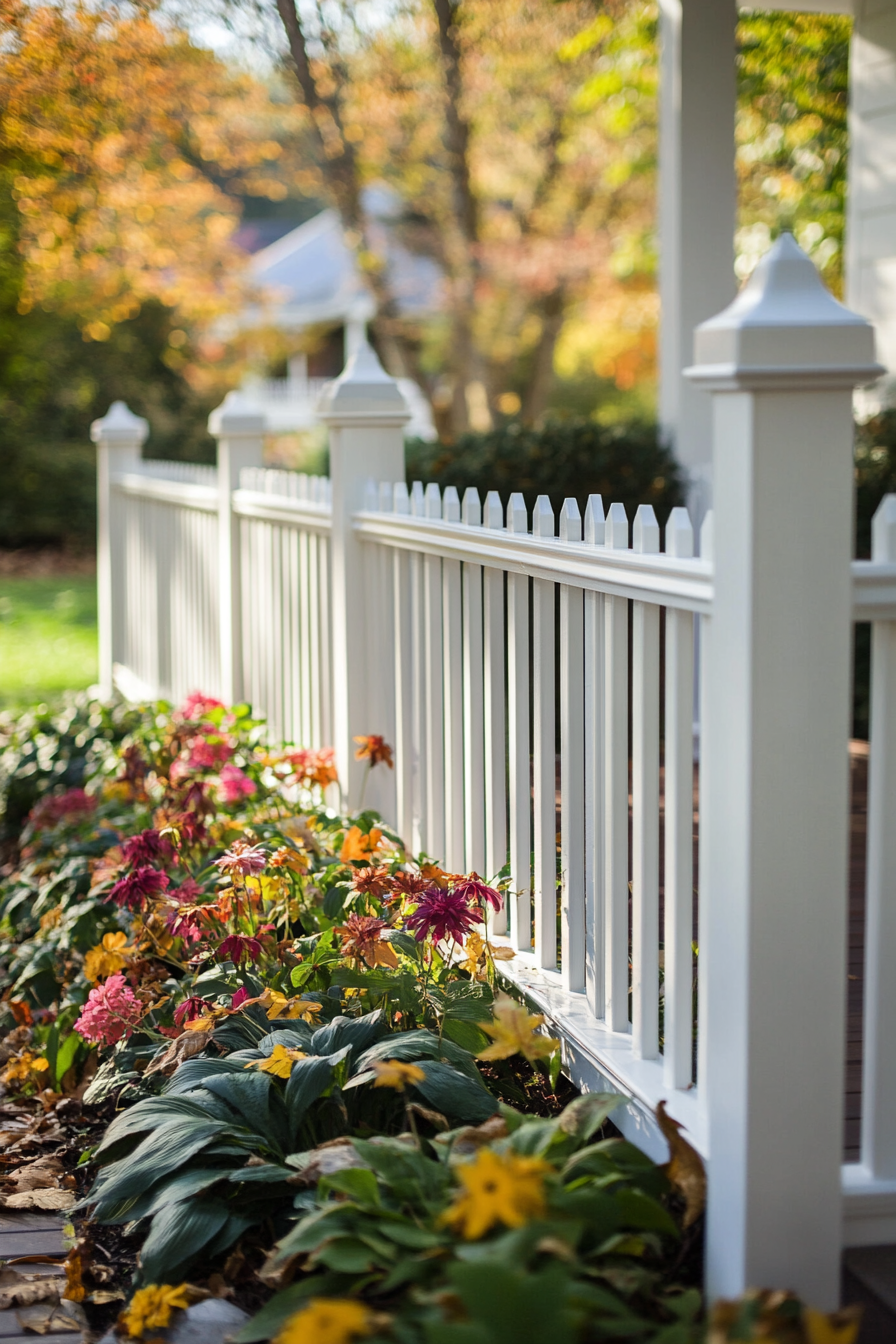Your deck railing is one of the most important parts of your outdoor living space.
Not only does it serve the crucial purpose of protecting people from falling off the deck, but it also provides an opportunity to add visual interest and style to your backyard.
The right railing design can completely transform the look and feel of your deck.
When selecting a deck railing, you’ll want to think about things like safety, durability, maintenance, view preservation, and aesthetic appeal.
Safety should always be the number one priority – make sure to check local building codes for height and spacing requirements.
Beyond meeting safety standards, you’ll also want to choose a material that can withstand exposure to sun, rain, snow and other elements.
Low maintenance options like aluminum, composite materials and vinyl railings are ideal for those who don’t want to deal with continual upkeep.
If you have a beautiful backyard view, an open railing style may be preferable to maintain sightlines.
And last but not least, deck railings offer a chance to reflect your personal style.
✨Click to Get My 101 FREE Designer Room Ideas
Classic Wood Railings
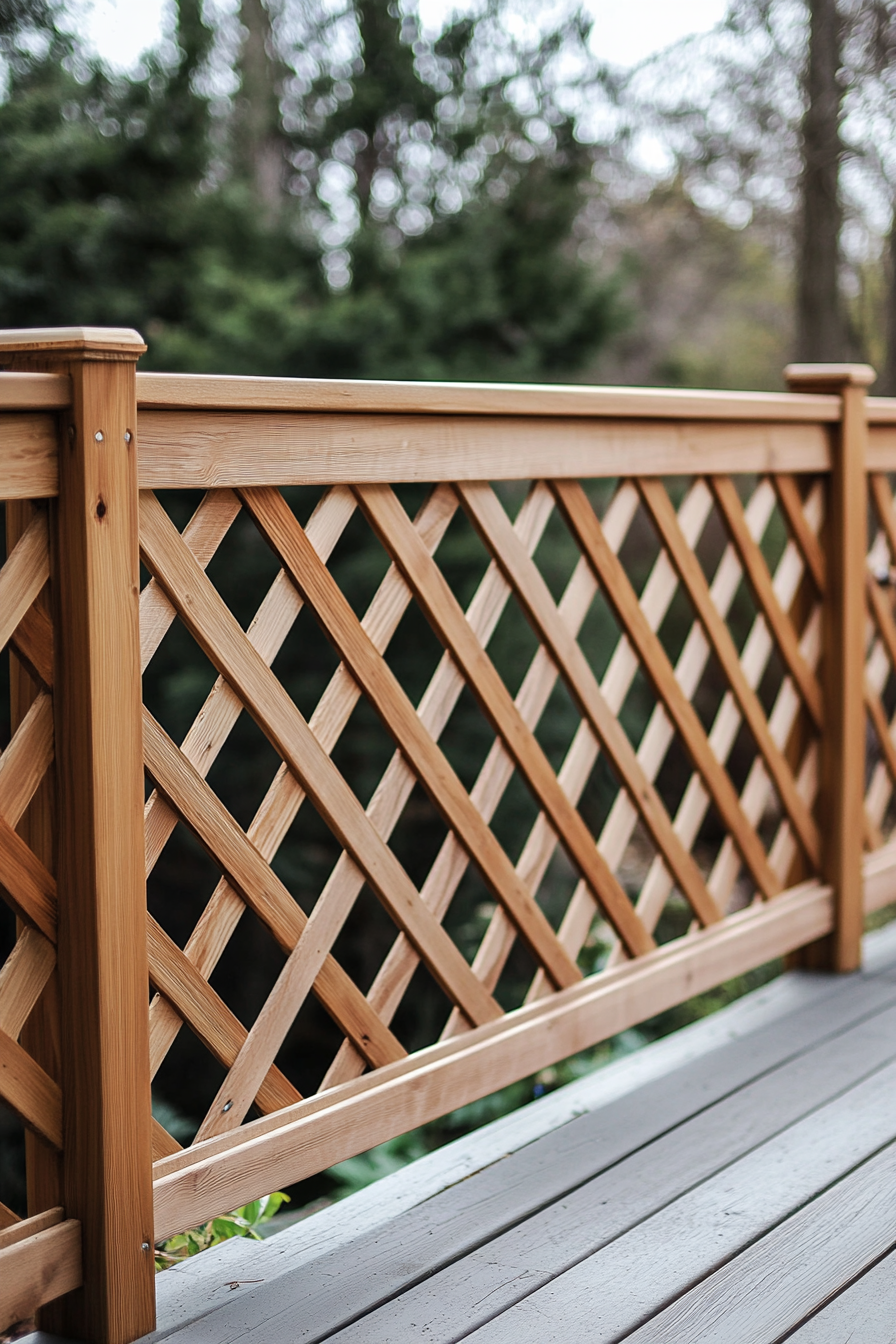
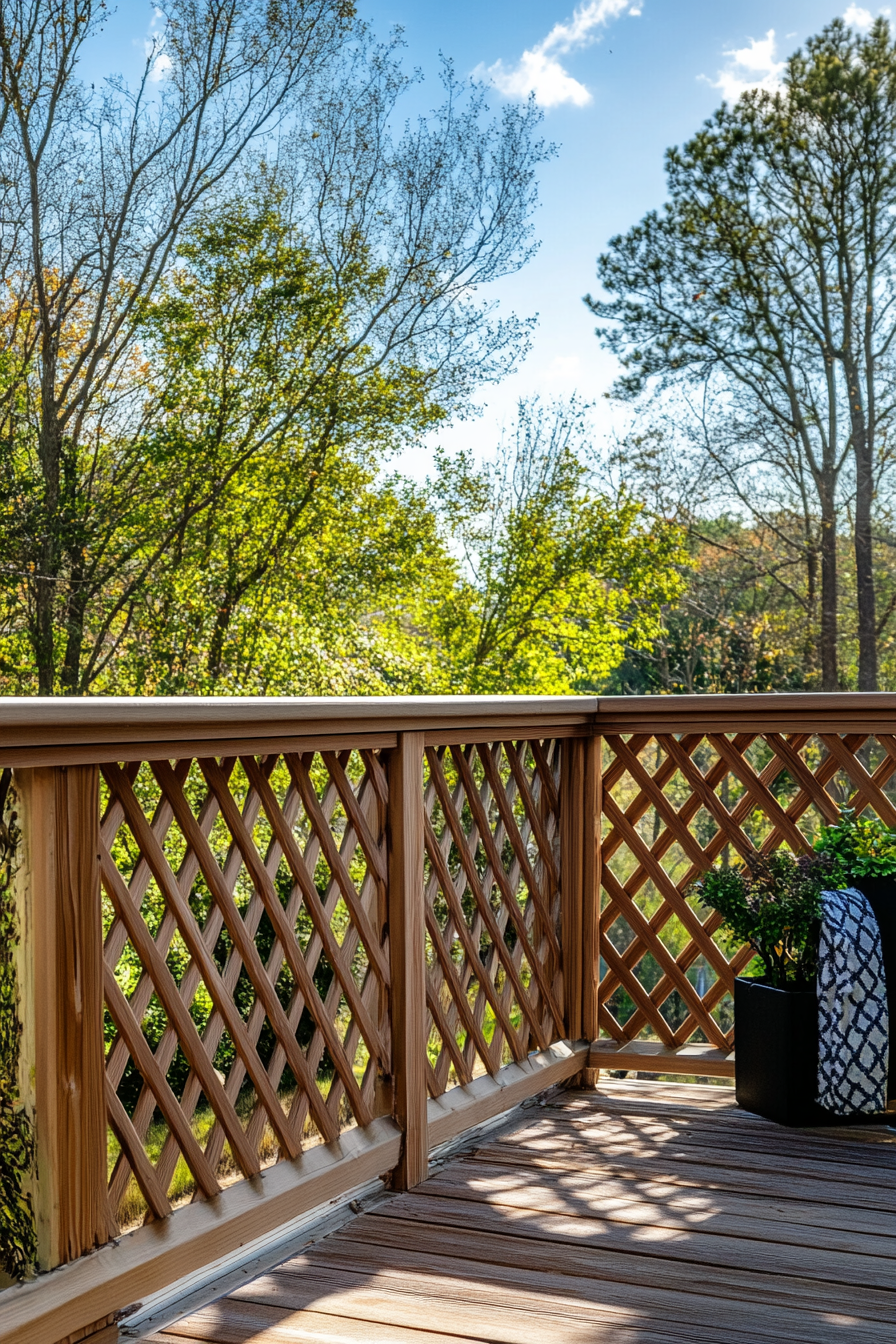
Nothing beats the classic charm and natural beauty of wood deck railings.
Wood railings come in a variety of styles, from simple straight balusters to more intricate designs.
One popular wood railing option is the lattice pattern.
This style features crisscrossing diagonal wood slats that infuse a traditional look with a hint of modern farmhouse flair.
The open spaces between the slats allow some visibility of the yard while still providing safety and privacy.
Wood railings can be crafted from cedar, redwood or pressure treated woods like pine.
Redwood and cedar offer natural decay resistance, but any wood will need proper sealing and maintenance with stains or paints for longevity outdoors.
Unfinished wood will weather to a gray patina over time.
But part of wood’s appeal is the ability to customize the stain or paint to any color scheme.
Professionally built wood railings typically cost $45-$100 per linear foot installed.
DIY kits for simple designs can reduce costs substantially, but may require more work to assemble.
Beyond the upfront expense, expect to refinish wood railings every 2-4 years to keep them looking their best.
The classic style and customizability of wood makes it a perennial choice for deck railin
A traditional wood railing design never goes out of style and can enhance the character of your outdoor living space.
Aluminum Railings

For a durable and low maintenance railing option, aluminum is an excellent choice.
Aluminum deck railings are lightweight, resistant to rust and corrosion, and require virtually no upkeep.
Simple powder coated aluminum railings start around $35 per linear foot, making them an budget-friendly option as well.
Minimalist aluminum cable railings offer an ultra-modern look.
Horizontal cables spaced 4-6 inches apart stretch between aluminum posts to create an unobtrusive see-through railing.
This style maximizes views from the deck while still meeting safety standards.
Cable railings run $55-$100 per linear foot installed.
Upgrades like LED lighting or decorative post caps can add aesthetic appeal.
For a more traditional look, aluminum railings are also available with picket, lattice or glass infill panel designs.
These infill options provide more privacy and visual interest than a simple cable railing.
Adding curves to aluminum railings can also help them better complement homes with architectural elements like arched windows.
Beyond a sleek modern aesthetic, aluminum is one of the strongest and most durable deck railing materials.
It holds up well to weather fluctuations and elemental exposure.
And since aluminum doesn’t need periodic refinishing like wood, it will continue looking great year after year with minimal maintenance.
Aluminum’s strength, longevity and affordable pricing make it a go-to choice for contemporary deck railings.
Glass Railings
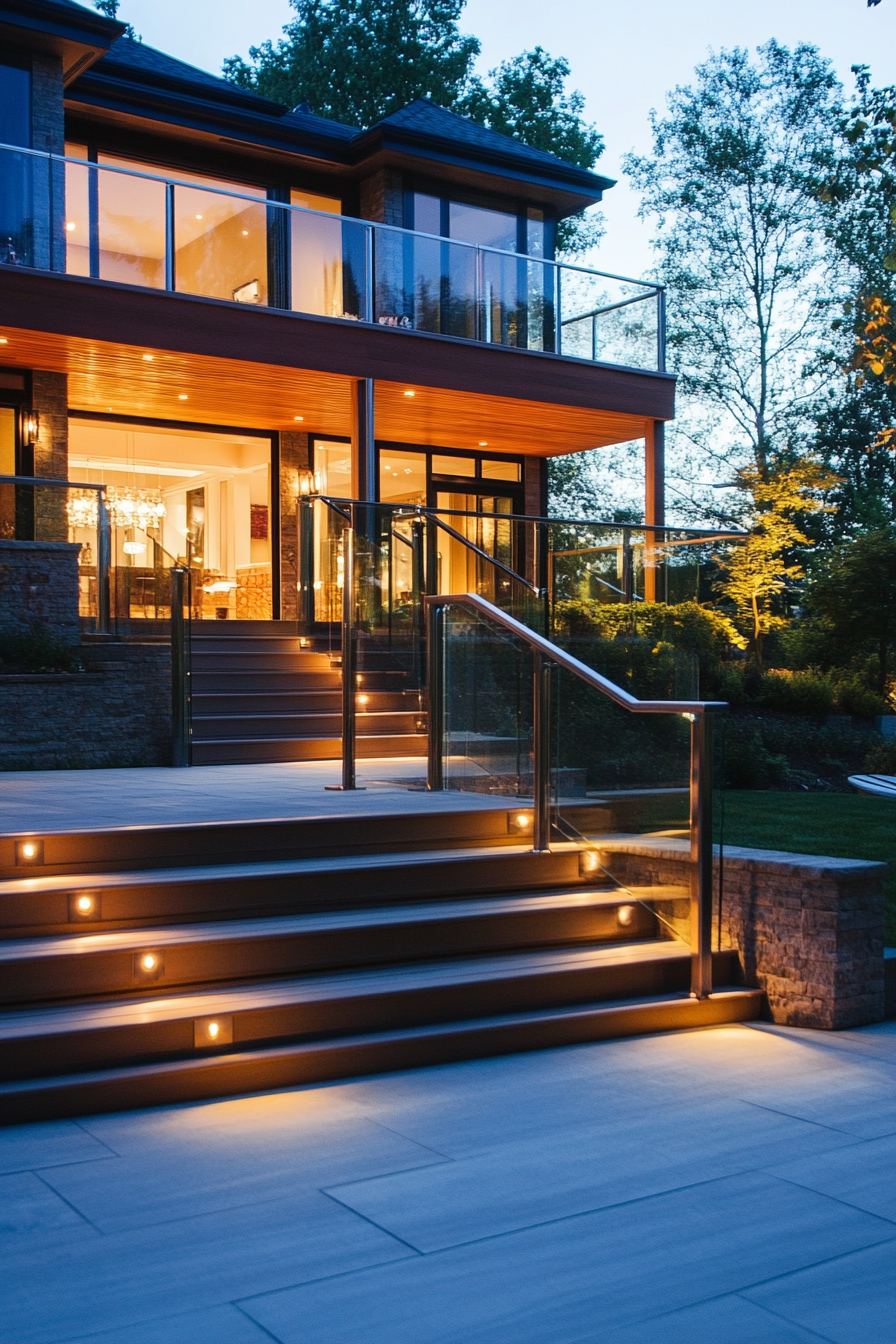
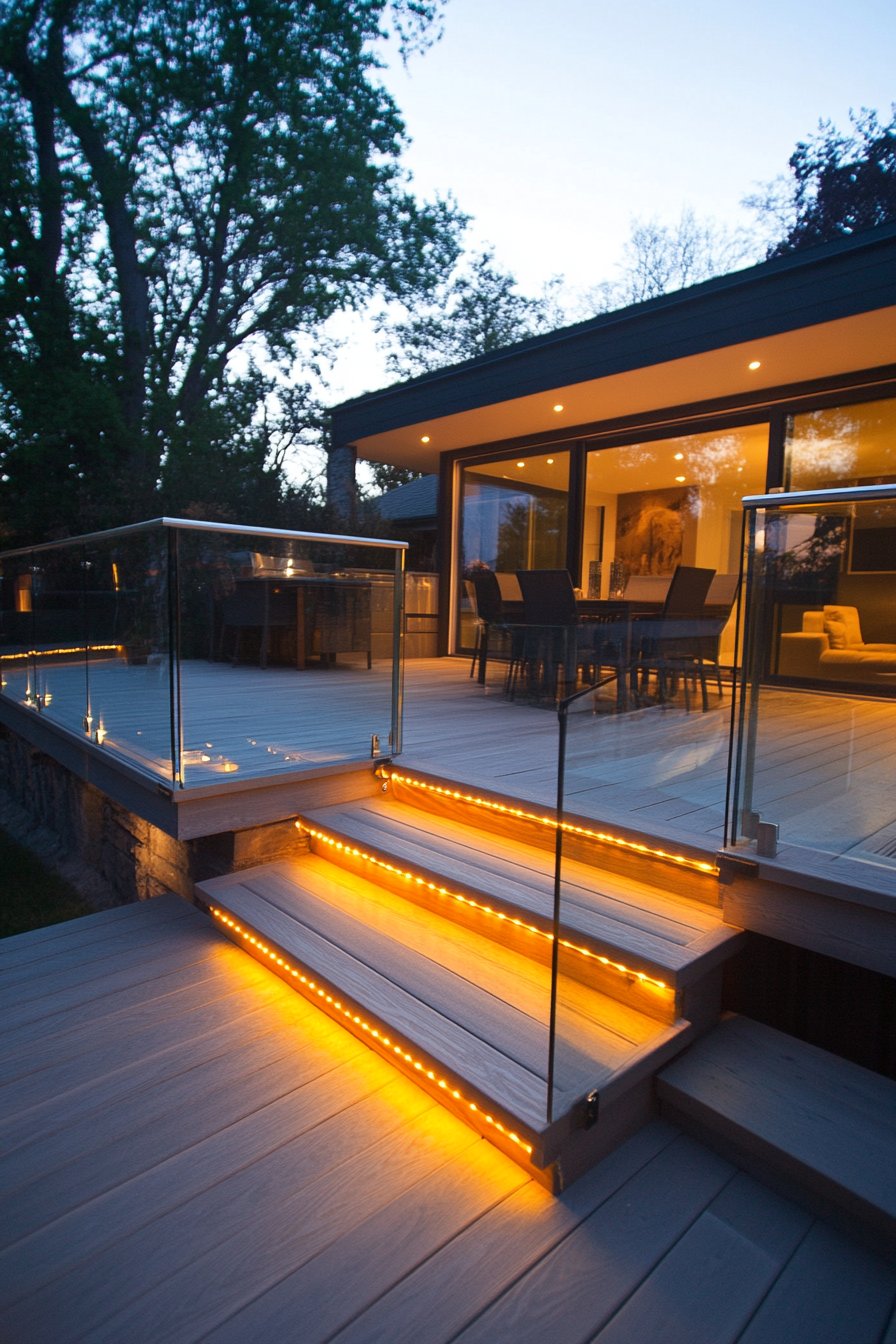
Few materials can match the sheer elegance of a glass deck railing.
Transparent glass infill panels or balusters allow for unobstructed outward views while preventing falls over the edge.
Tempered glass is very strong and safe for railing use.
The dazzling transparency gives a lightweight, floating effect to the railing.
And LED lighting can be incorporated to create a dramatic illuminating effect at night.
Frameless structural glass railings attach sleek glass panels directly to the deck and support posts.
This creates a nearly invisible barrier perfect for gazebos or modern designs.
Stainless steel posts and hardware provide the most complementary look with glass.
For a more structured look, horizontal cable railings can incorporate tempered glass balusters.
The glass inserts visually open up the railing compared to traditional wood balusters.
This style costs $70-$120 per linear foot installed.
The biggest downside to glass is the price tag.
Fabricating and installing a custom glass railing typically starts at $100 per linear foot and can go much higher.
Ongoing maintenance is relatively minimal, but the high initial investment makes glass railings cost prohibitive for many homeowners.
But for those desiring dramatic views or a contemporary flair, glass is in a class of its own.
The transparent shimmer and customizability of glass railings make a uniquely breathtaking addition to any deck.
Composite Railings
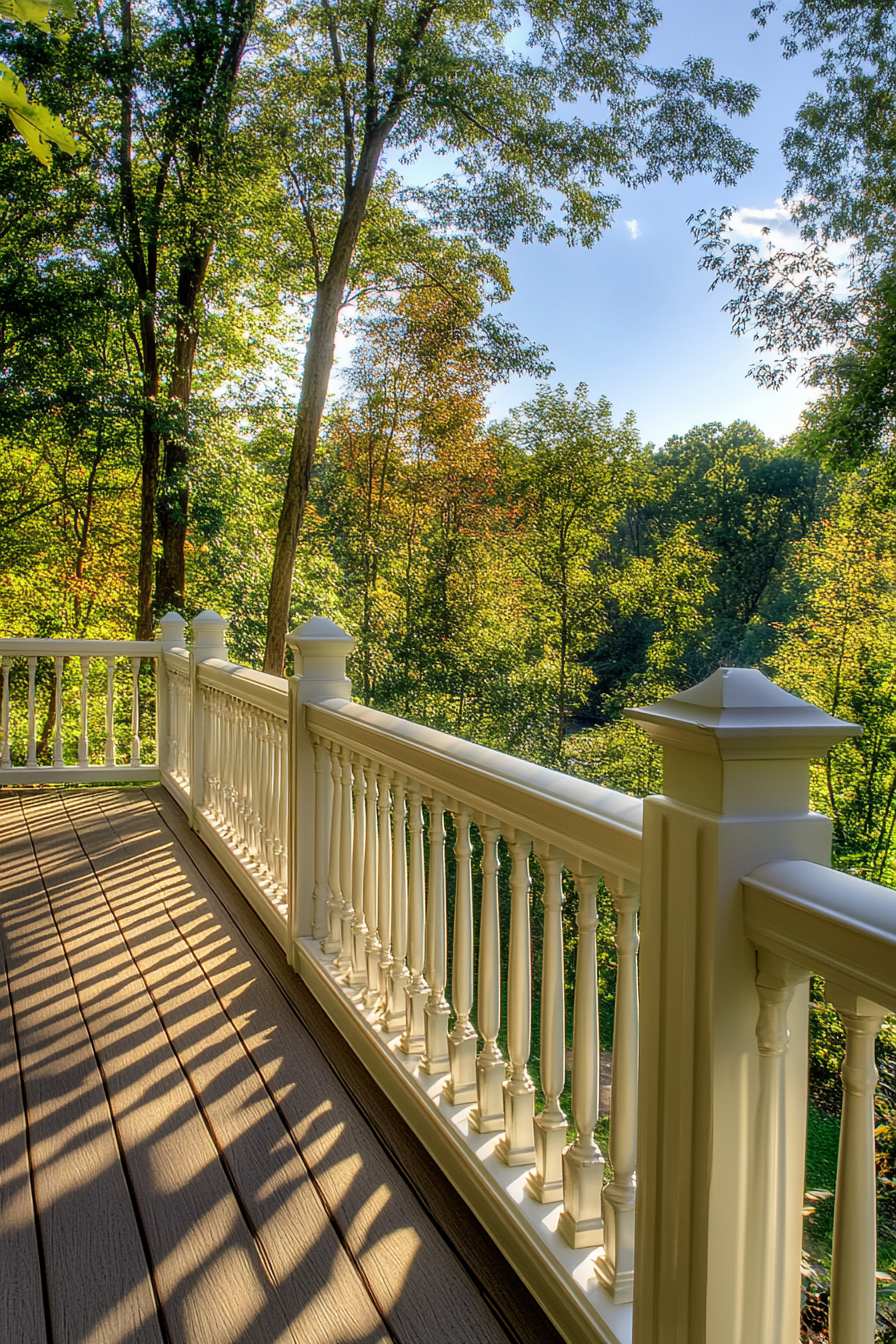
Composite decking has become popular in recent years for its durability, low maintenance and wood-like appearance.
Many composite decking manufacturers like Trex also offer matching composite railing components.
The railing pieces consist of a mix of recycled plastic and wood fibers formed into traditional balusters, posts and caps.
Composite railings pair perfectly with composite decking to deliver consistent colors and textures.
For example, a grey Trex decking with matching steel grey balusters and black aluminum posts creates a cohesive modern aesthetic.
Mixing the traditional look of composite balusters with the durability of aluminum frame components allows for customization based on your style and budget preferences.
At $65-$100 per linear foot installed, composite railings have a moderate upfront cost.
But they require no staining, sealing or painting for up to 15 years.
Occasional soap and water cleaning is all that’s needed to maintain their appearance.
The engineered materials resist decay, splintering and insect damage that can plague wood railings.
With wood-like aesthetics and all-weather durability, composite railings are ideal for low maintenance, high traffic decks.
Their customizable designs make coordinating with decking simple for a pulled together look.
Achieve the beauty of natural wood without the continual upkeep using composite railing systems.
✨Click to Get My 101 FREE Designer Room Ideas
Metal Railings
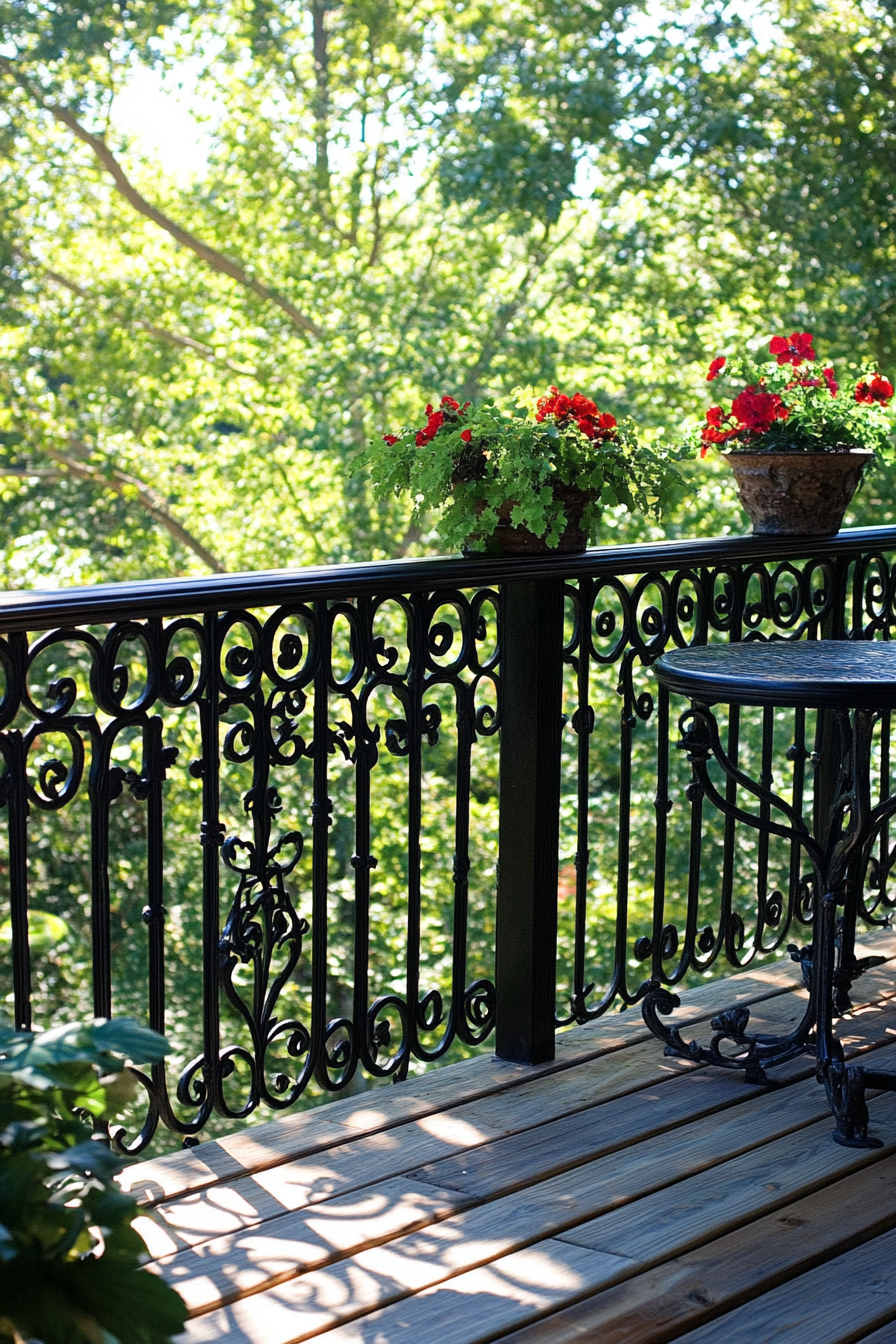
Beyond aluminum, other metal railing options like steel, iron and stainless steel make an ultra-durable choice for decks.
Wrought iron railings with intricate scrollwork and cast details provide a classic, ornate look.
The unique styling offers old world character that can enhance Mediterranean or cottage style homes.
Stainless steel cable railings have a lighter, more modern appearance.
Their sleek transparency maintains sightlines to maximize waterfront or mountain views.
Staggering the spacing and heights of the cables creates visual interest and safety redundancy.
Custom coverings are available to match the cabling to surrounding aesthetics.
Metal railings start around $70 per linear foot for simple steel designs.
More complex custom ironwork can cost $200 per foot or more.
Labor-intensive installation, materials and finishing all impact pricing.
Ongoing maintenance may involve resealing, touch-up painting or cleaning oxidation depending on climate and material.
But one of the biggest benefits of metal is its incredible strength and durability.
Steel and iron designs will easily last decades with proper care.
For coastal areas, stainless steel resists corrosion from ocean spray.
And metals can withstand extreme weather fluctuations from blistering heat to pouring rain and snow loads.
If you value unique, durable craftsmanship, metal railings impart timeless sophistication
The strength and intricate potential of iron, steel and stainless steel make them smart deck railing investments.
Picket Railings

No railing style better epitomizes classic Americana than the traditional picket railing.
Rows of evenly spaced vertical balusters elicit images of charming cottages and sprawling farmhouse porches.
The clean lines and familiar form lend a casual elegance perfect for country, cottage and traditional deck designs.
Wood and composite deck railings commonly incorporate picket-style balusters.
But you can also find aluminum and vinyl systems to get the same look with less maintenance.
Spacing balusters closer together provides more privacy and protection for pets and children.
Wider 4-5 inch gaps create a more visually open railing.
Picket railing costs vary based on materials used and baluster spacing.
But expect pricing comparable to other similar railing styles, in the range of $50-$100 per linear foot installed.
Opt for durable, low maintenance materials to minimize time spent sealing, staining and repairing pickets.
No matter what deck aesthetic you gravitate toward, a classic picket railing design offers welcoming charm.
The clean lines harmonize effortlessly with any style home exterior.
For traditionalists, pickets capture the essence of homespun style and practicality.
Patterned Railings
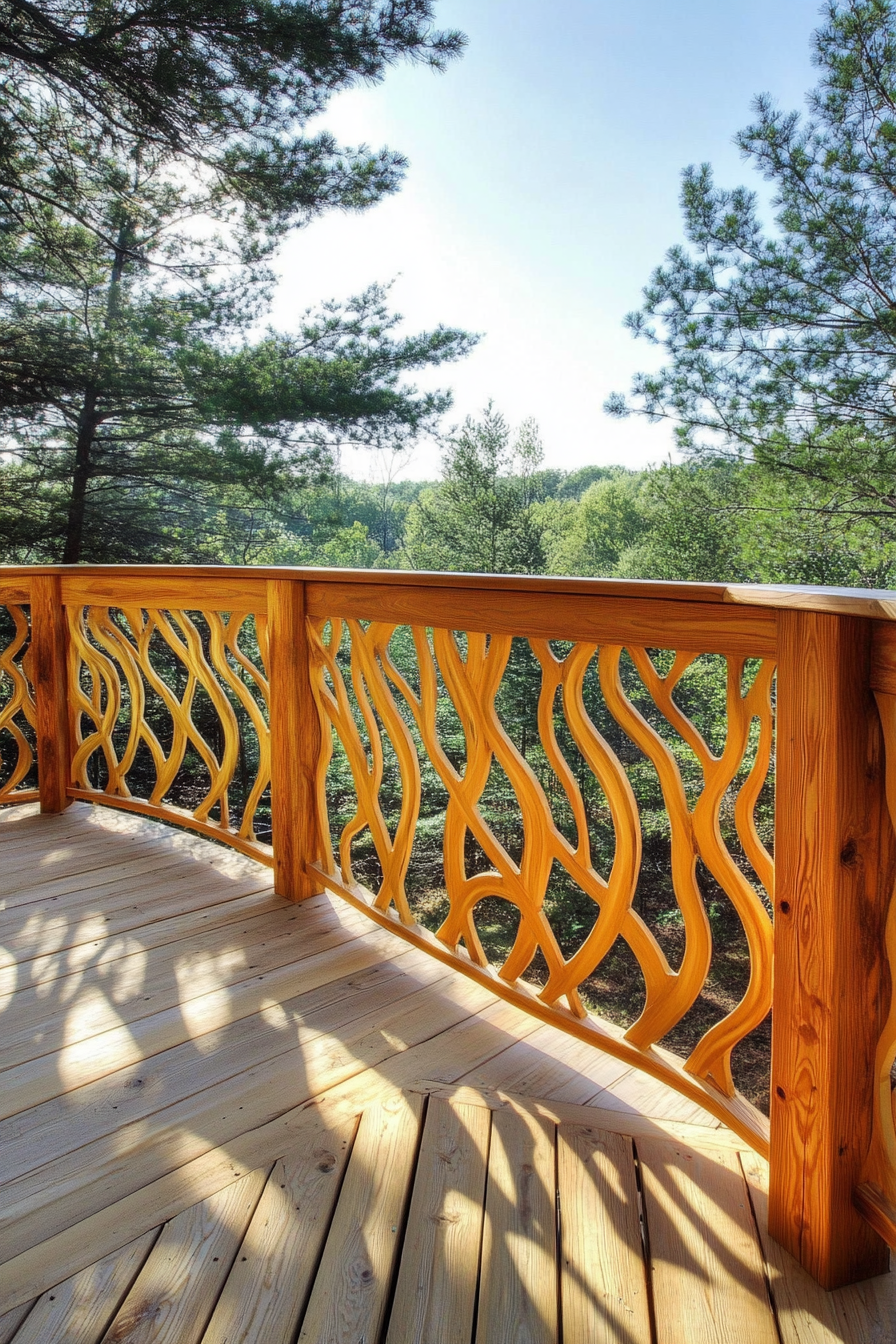
Make a bold statement by incorporating pattern into your deck railing design.
Geometric patterns like zigzags, chevrons and crisscrosses provide visual punch to any style deck.
Combining vertical and horizontal baluster pieces creates intriguing depth and shadow lines.
For a three-dimensional look, rotate overlapping balusters in opposing directions.
Freeform patterns can also make a unique addition.
Try subtle curves for an approachable feel, or go all out with sweeping wavelike forms.
Mixing freeform and linear patterns together adds organic contrast.
Playing with two different colors or materials in the same railing boosts the dynamic effect.
One example is pairing composite balusters with aluminum rail frames.
Different colors, shapes and textures blend in creative new ways.
Just be careful to avoid overly busy combinations.
Hands-on DIYers can craft custom patterned railings from wood.
But professional metalworking or welding skills are needed to carefully assemble intricate steel, iron or aluminum pieces.
The more complex the design, the higher the price tag at $100 per linear foot or greater.
If your budget doesn’t allow for custom work, some retailers offer patterned railing infills to insert into standard metal frames.
No matter what colors and shapes you choose, unique patterns and textures give your deck railing an artistic sensibility.
Embrace your creative side and use railings as an opportunity to craft a dynamic outdoor living space.
Rope Railings
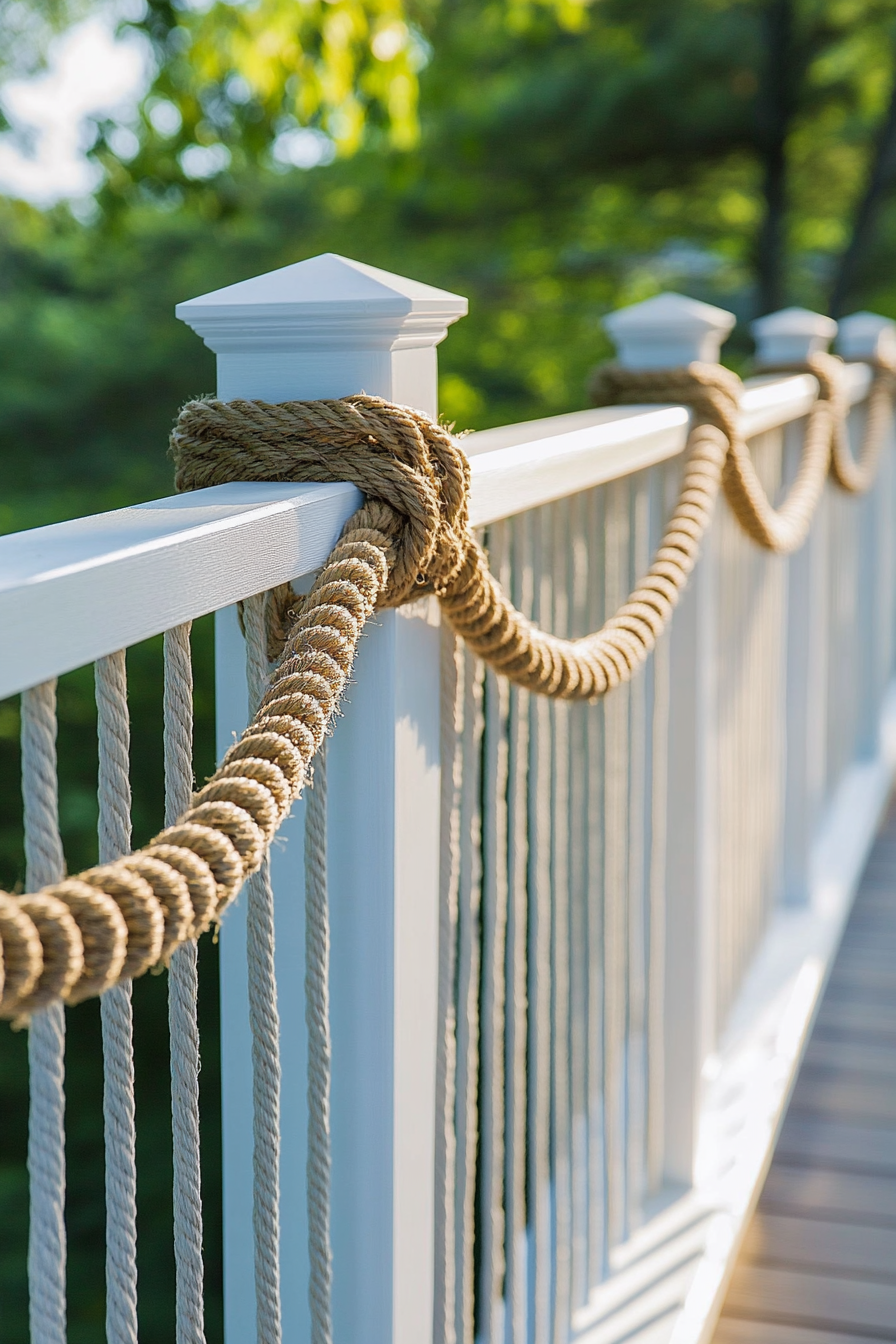
For a breezy nautical vibe, rope railings are a novel choice to consider.
Made from durable synthetic fibers, rope railing systems consist of horizontal cables threaded through plastic or metal stanchions.
The rope cables can feature knots between each section for added texture.
Matching rope handrails are also available to complement the deck rails.
Rope railings work especially well for beach houses, lake homes or coastal cottages.
The casual ropes evoke the spirit of sailing and adventures by the water.
Their unfussy style contrasts beautifully against intricate house trims or natural stone.
For the easiest maintenance, choose a synthetic rope material that won’t mildew or deteriorate in wet weather.
Affordable rope railing kits start around $30 per linear foot.
Higher end systems with 316 marine grade stainless steel hardware and customization run $70-$100 per foot installed.
Minimal upkeep is needed beyond occasionally tightening rope tension.
Traditional cable railings lend a lightweight, transparent effect.
But rope railings take the nautical theme even further with natural fiber aesthetics.
The unique personality and carefree vibe of rope systems inject free-spirited charm into any outdoor living space.
✨Click to Get My 101 FREE Designer Room Ideas
Railing Planters
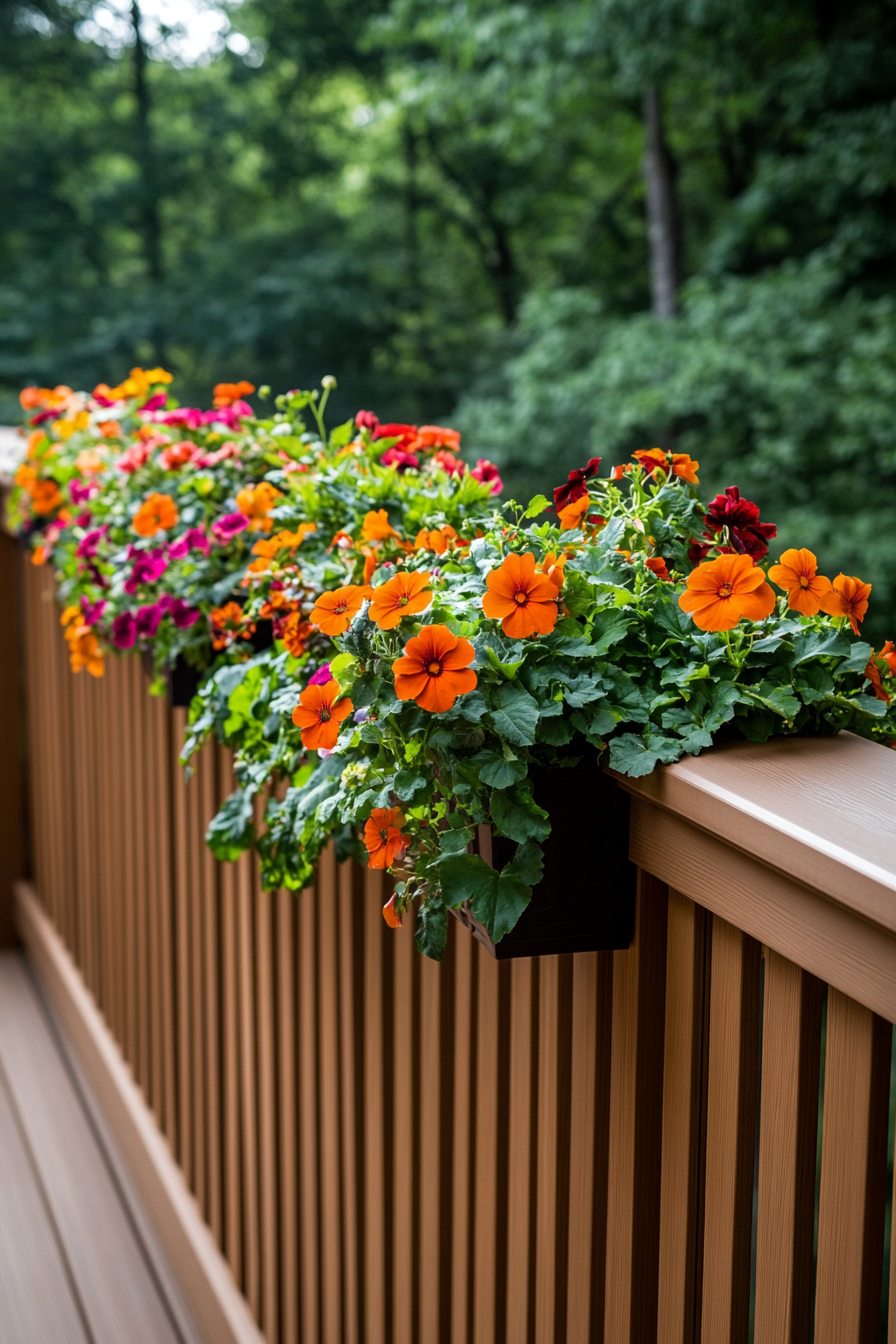
Incorporating plants into a railing design delivers the ultimate fusion of form and function.
Built-in planters allow you to cultivate flowers, herbs or trailing foliage without taking up deck space.
The most common approach is designing rectangular railing infill panels to hold potted plants.
Concealed metal or plastic boxes nest inside the wood or composite railing frames.
For easier planting access, opt for removable railing planter boxes.
Box sizes ranging from a foot to several feet wide enable growing everything from petite succulents to bountiful vegetables and flowering vines.
Just be sure the railing and posts can support the additional weight when soils are wet.
Infill railing planters typically cost $70-$120 per linear foot depending on materials and intricacy.
Custom designs for larger spaces can run even higher.
The initial investment is significant, but the impact is huge.
Flowers and foliage cascading over deck rails create stunning vertical gardens to admire.
Beyond aesthetics, planted railings help filter views, improve privacy and purify the surrounding air.
Take the opportunity at hand to add ornamental edibles like strawberries or mix your favorite annuals and perennials.
With proper drainage and care, railing planter boxes allow your deck landscaping creativity to grow vertically.
Post-to-Rail Railings
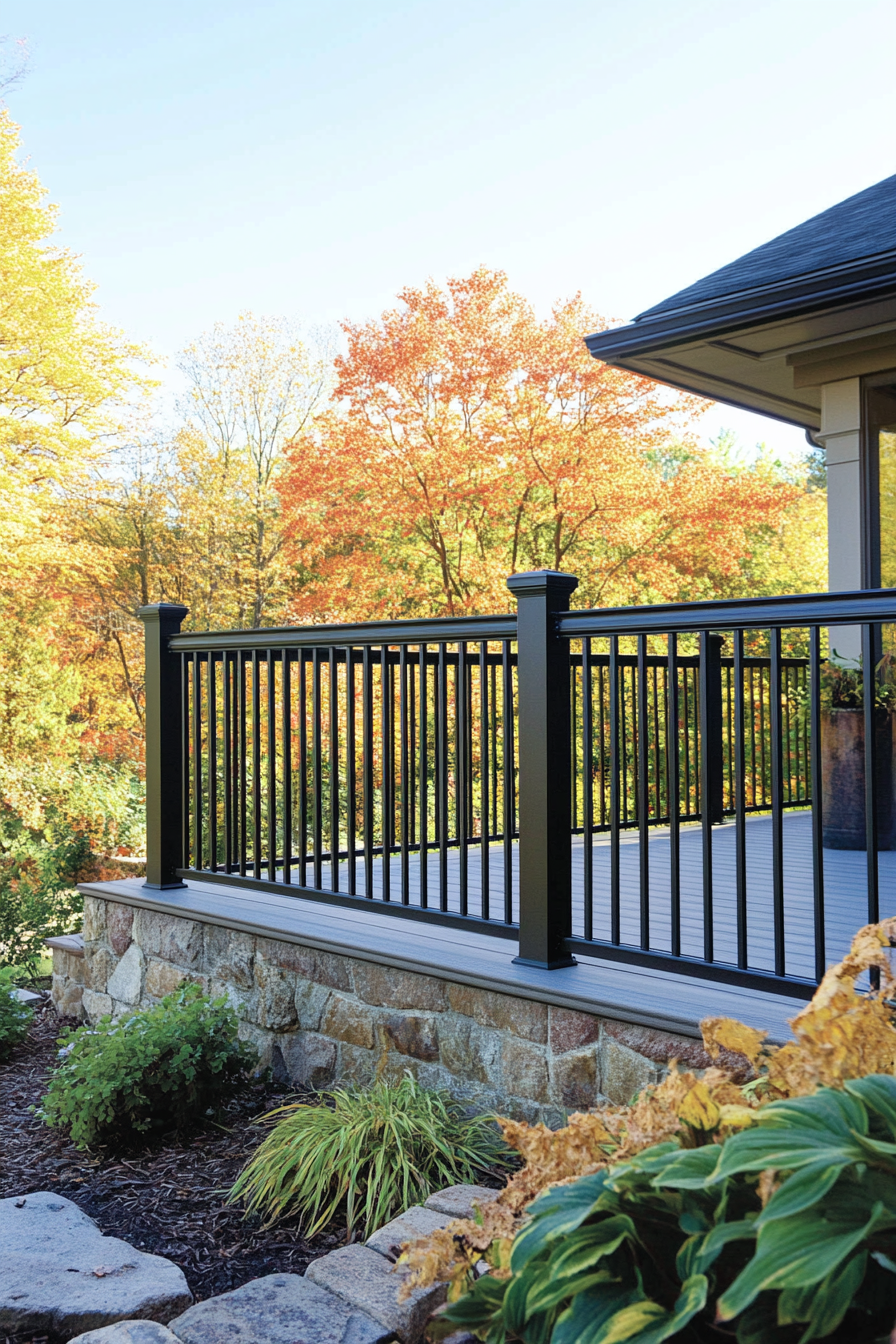
Post-to-rail systems take you back to the basics with a simple but classic railing structure.
Just two horizontal rails stretch between vertical posts, with no additional balusters or ornamentation.
Available in a variety of materials, from wood to metal to composite, the clean lines exude understated elegance.
For a lightweight feel, aluminum post-to-rail railings color coordinate easily with other deck features.
Or opt for composite post sleeves over wood posts to fully integrate railings with a composite deck design.
Using the same base colors and materials throughout lends a seamlessly cohesive look.
Without balusters to work around, integrating post-to-rail railings with steps, benches and other structures is easier.
The straightforward design reduces visual clutter to keep sightlines open.
Rail height variations add architectural interest while maintaining the unfettered views.
Post-to-rail railing costs start around $30 per linear foot for basic systems.
The simple installation makes do-it-yourself assembly achievable for many homeowners.
While open and minimalist, building code approved post-to-rail railings meet safety regulations for deck barriers.
Sometimes the purest design is the best.
Post-to-rail railings embody functional sophistication.
For contemporary or transitional spaces, this stripped-down railing style allows the beautiful outdoor surroundings to take center stage.
Curved Railings
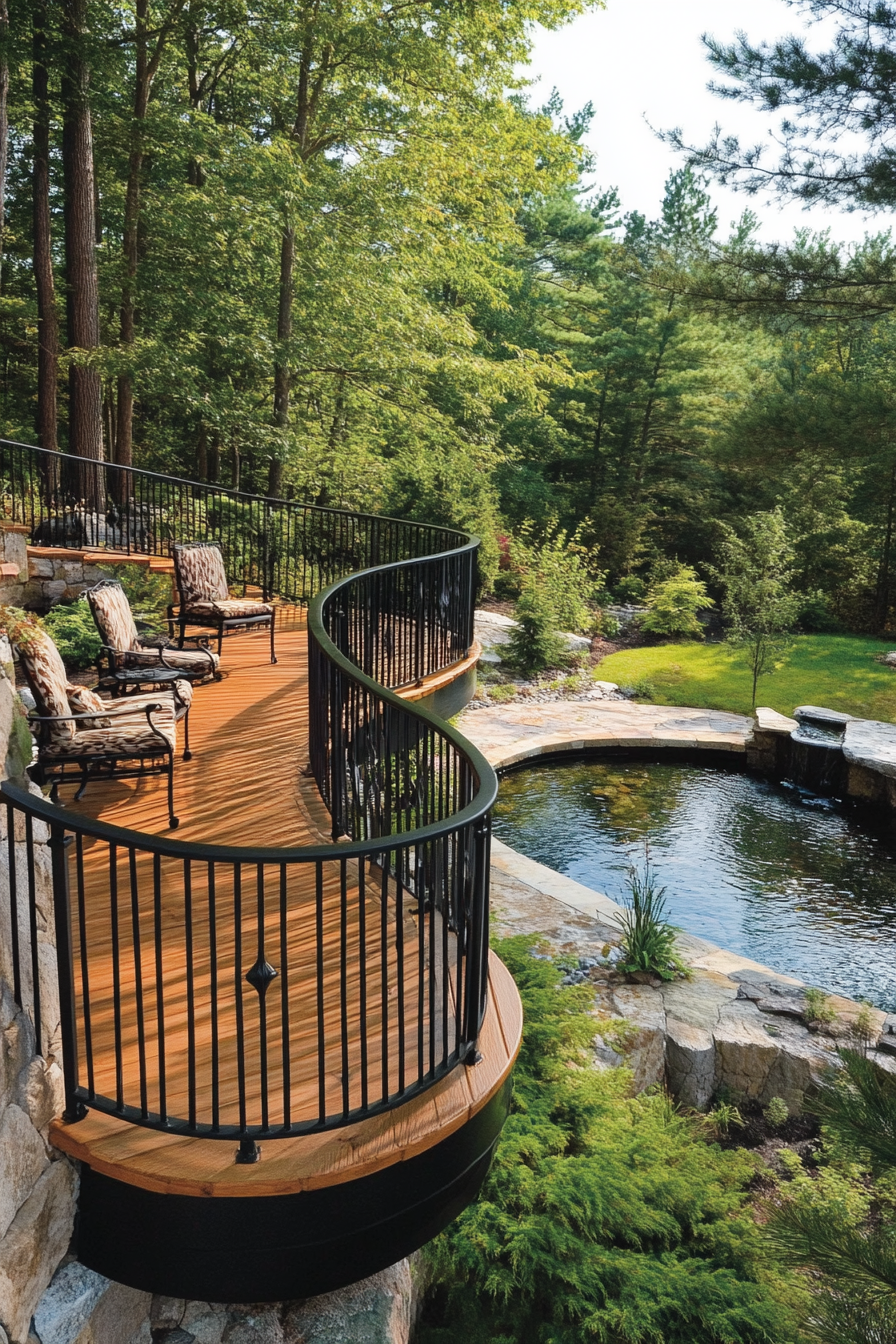
Most deck railings follow a linear straight-line form simply out of ease and cost considerations.
But incorporating curves into your railing design elicits nature inspired elegance.
Flowing lines complement properties embracing elements like curved walls, arches and custom landscaping.
For poolside decks, curved railings mirror and accentuate the oval forms.
Subtle curves, like gently angling deck railings to trace the deck perimeter, make an approachable yet upscale statement.
Full flowing curves and serpentine shapes create a more dramatic effect.
Combining curved and straight sections adds designer flair without overcomplicating the structure.
For metal railings, bending the frame components requires special skills and labor.
Expect to pay $125-$250 per curved linear foot for specialty fabrication and installation.
Curved wood railings constructed from smaller segmented pieces demand intricate carpentry as well.
But the extra effort pays off with an utterly unique railing profile.
Radiant curves and arcs reflect light differently than straight lines for visual dynamism.
Any railing style, from pickets to post-to-rail, receives a refined elegance boost when given the curved treatment.
For decks with upscale architectural details or custom styling, consider incorporating fluid curves into the railing borders.
Contrasting Railings
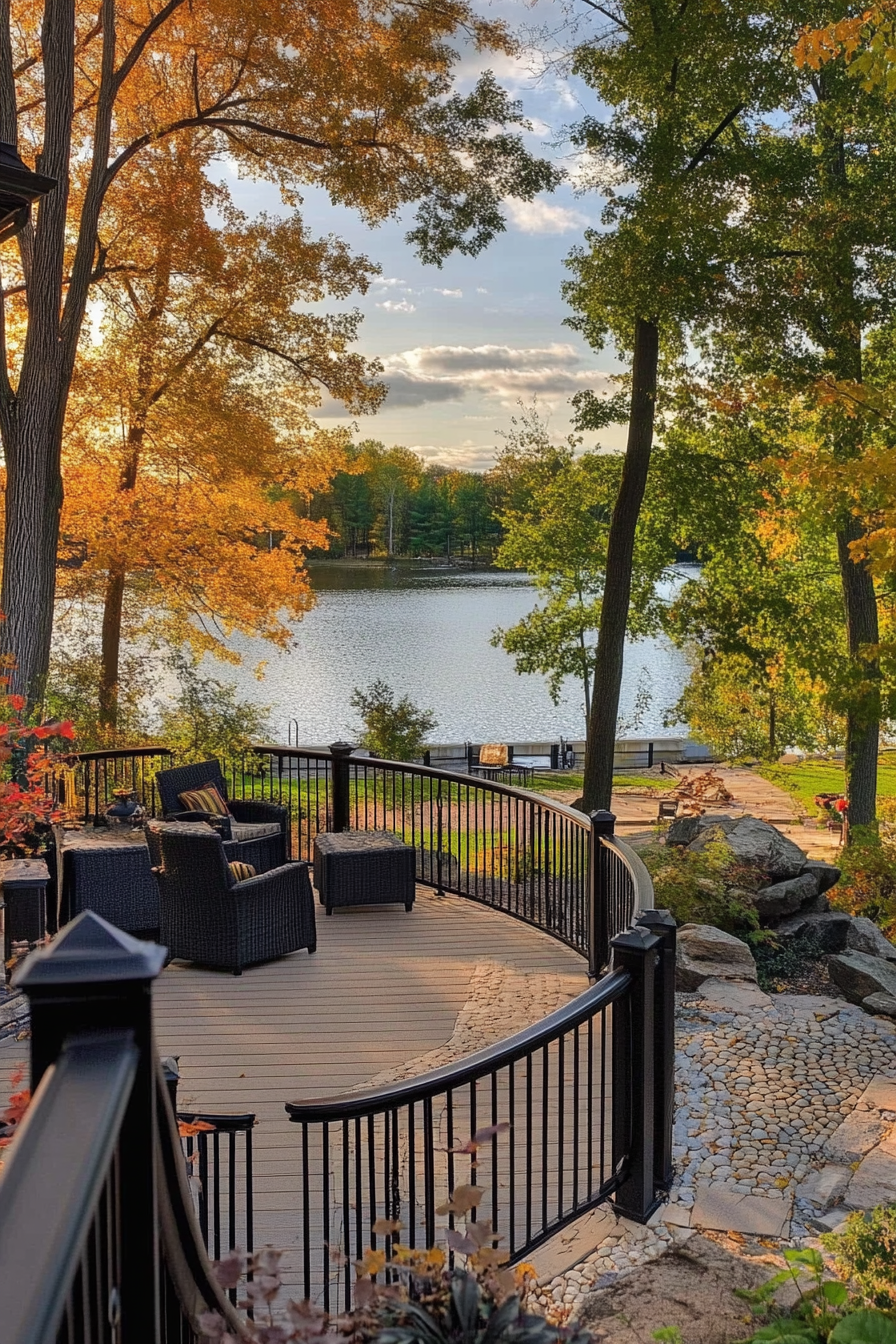
Why blend in when you can stand out?
Choosing deck railing colors and materials that pop against the surroundings cranks up the design drama.
Contrast draws the eye to selectively highlight or obscure parts of the deck.
Using color schemes informed by the color wheel is key to creating inviting palettes.
For a sunny style statement, bright white railing balusters distinguish themselves against darker decking and exterior tones.
Black metalwork makes an equally bold impact against light colored deck boards and home finishes.
High contrast light and dark pairings feel crisp and contemporary.
Softer contrast comes from matching cool and warm shades like sky blue rails on brown decking.
Monochromatic beige railings and decking allow the vibrant green landscape to take center stage.
Gray-toned railings with neutral weathered decking embodies comfortable elegance.
Take design risks without going overboard.
Contrasting railings in unique colors, textures or shapes make a memorable impact while still harmonizing with the rest of the space
Let your vibrant creativity shine through in the deck details.
✨Click to Get My 101 FREE Designer Room Ideas
DIY Recycled Pallet Railings
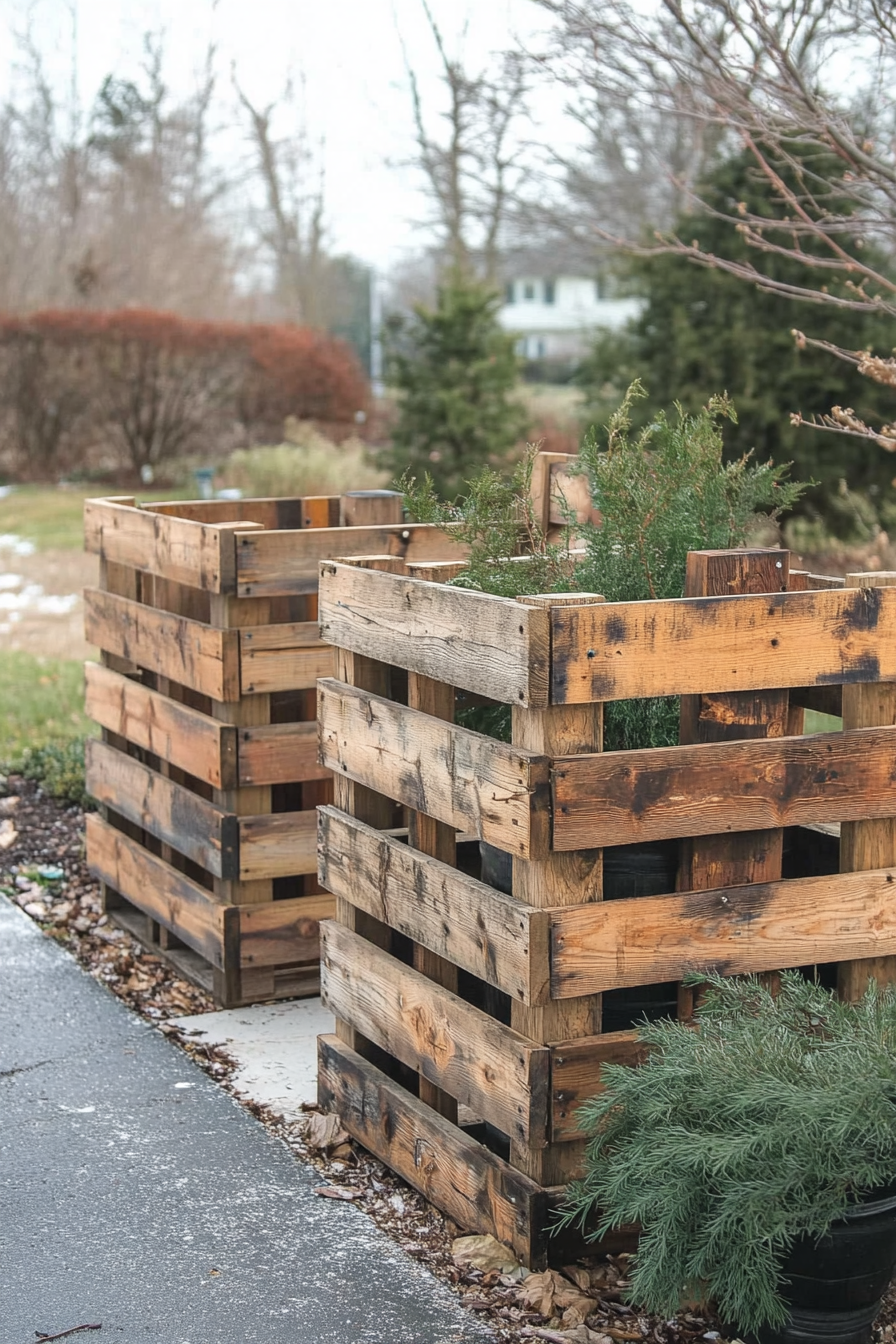
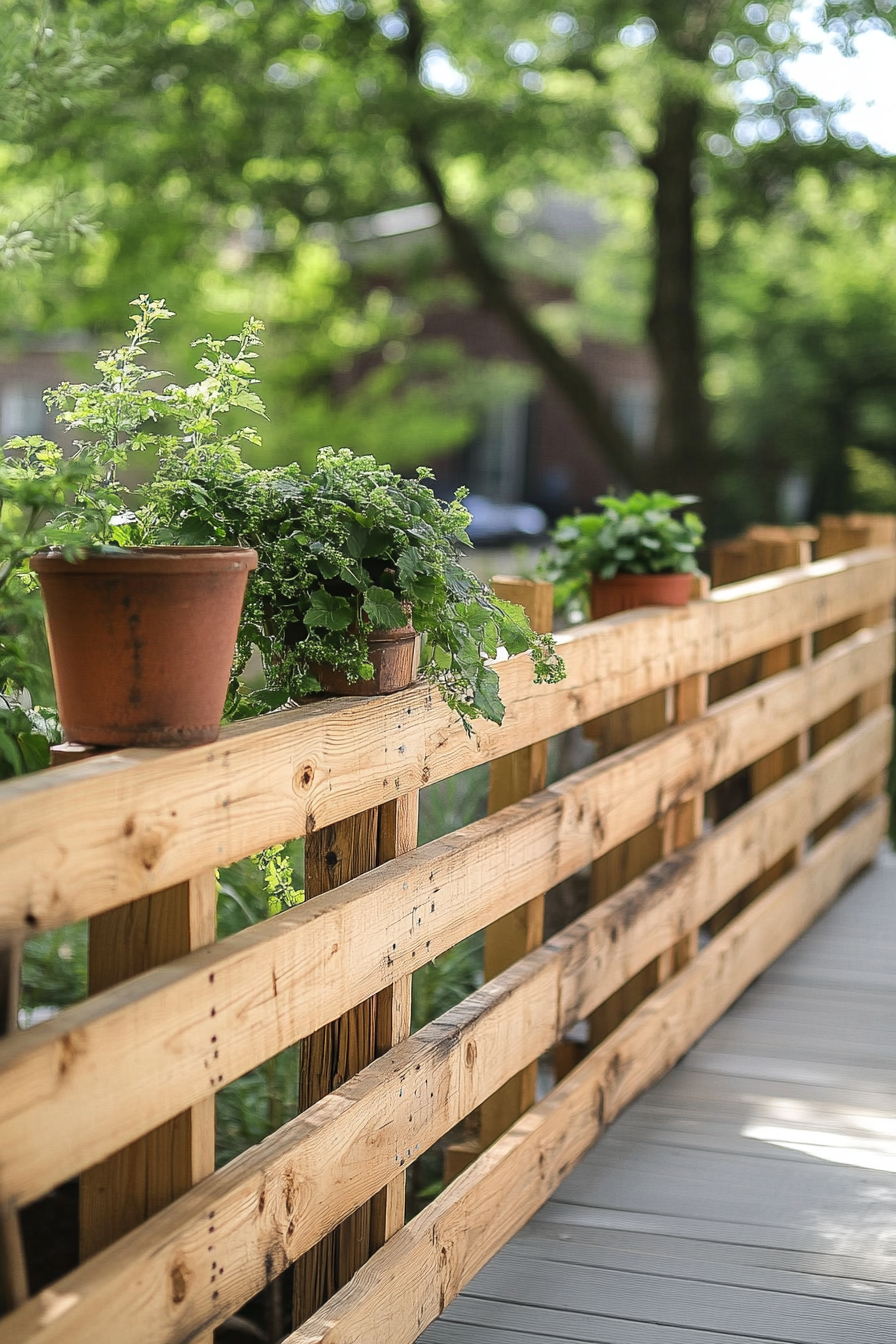
Budget-friendly, eco-friendly and full of rustic farmhouse charm, recycled pallet railings check all the boxes.
Old shipping pallets are easy to source for free or cheap.
Many home improvement stores gladly hand over discarded pallets.
Look for heat-treated pallets in good condition without broken boards or protruding nails.
Sawing or chopping pallets into sections provides ready railing pickets.
Wire brushing and sanding smooths and preps the cut pallet wood.
Staining enhances thegrain and ties the recycled pickets together.
For post attaching, use 4×4 treated lumber or fence posts set in concrete.
Space pallet railing pickets 3-4 inches apart for safety and code compliance.
Flipping picket direction for interest and reinforcing connections are best practices.
Leave a 1-2 inch overhang into post pockets for sturdiest connections.
Upcycling old pallets into railings takes some carpentry skills, but provides great cost savings.
The eco-friendly reuse also prevents useful material from clogging landfills.
For those with DIY abilities, pallet railings offer a fulfilling sustainable project with stellar Scandi-chic style.
Your deck railing choice impacts aesthetics, functionality and safety for years to come.
Select durable, low maintenance materials tailored to your climate.
Incorporate designs that harmonize with your home’s architecture and surroundings.
Mix colors, textures and shapes for customized creative flair.
And consider how different railing styles can optimize views, light and privacy in your outdoor living space.
With myriad designs to inspire, from classics like wood pickets to curve cutting edge cable systems, your ideal railing awaits.
Use this opportunity to amplify your deck’s design story.
Let these railing ideas guide you in choosing both form and function to elevate your outdoor oasis.
The right railing brings together safety, sustainability, personal style and curb appeal for an outdoor living space you’ll love enjoying for years to come.

